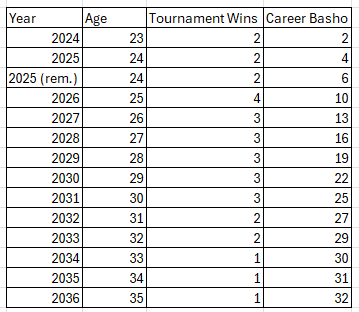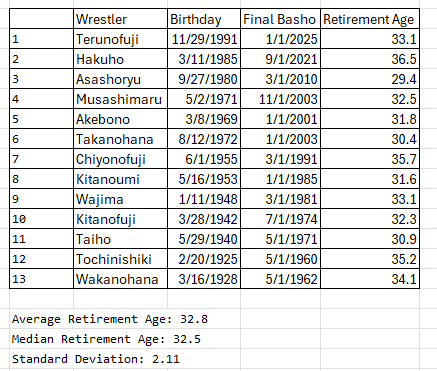We will discuss a couple ways to think about guessing how many Yusho (tournaments) Onosato will win in his career further down, but before you read that, guess how many Yusho you think Onosato will win the rest of his career in your head. He has already won 4 Yusho (tournaments), and he was born on June 7th, 2000 making him 24 nearly 25 as of being promoted to a Yokozuna. I also provide the list of most career Yusho in sumo history here but I think it’s good to have a relatively unbiased guess before actually diving into the numbers.
Mine using solely his age, his 4 current Yusho and having looked at most career championships above courtesy of Wikipedia I’m guessing 18. Remember yours and you can compare at the end with various assumptions and even use the models provided here.
Model 1 - Naive Assumptions - Build Up
Simply start with 5 (or a more reasonable number like 10) and ask yourself: do you think there is a 50%+ chance he gets that many Yusho in his career? So 5 is really easy - he’s almost guaranteed that many. 4 is 100% because he already has that many but I used a hypothetical of my thinking to show what it might look like continued.
In a sense this approach is thinking like a sports bookmaker. If you’re familiar with the spread, this is basically a simplified version of what they do1. If you’re not, imagine a really good basketball team like Team USA playing a team like Japan, then obviously the US will be favored and probably by double digits. So what the oddsmaker will do is essentially “spot” the Japanese team 15 or 20 points or however many they have to to make it 50/50 that Team USA can beat Japan by 15 points. That’s what the spread is and if the USA beat Japan by 16 then that’d be beating the spread.
I call this naive in the meaning that I make no assumptions. I just ask myself sequentially: is it 50% or more likely he reaches this career Yusho number. Sometimes thinking in a more structured way like this can be helpful.
Model 2 - Basic Assumptions and No Data
For Onosato this question is likely less about his skill and more about the number of opportunities he has to win a Yusho. He has yet to miss a match and he can hopefully keep up his sterling record on that front. But everyone gets old eventually, so we can essentially break down our problem into two sub-questions: how many Yusho wins will he get while active and when will he retire.
The retirement will affect how long he’s active so let’s start with that. Again no need to do a data deep dive yet so knowing he’s almost 25 and having some basic knowledge of wrestlers’ ages I think we can set some solid ranges: I’ll say that he retires somewhere between age 32/33 and 36/37 or he has ~8 more years to 12 more years left wrestling. I’d love if he went even longer like Tamawashi, but let’s split the difference and say he has 10 years left of top level sumo. Now we can move on to the “how many Yusho wins he will get while active” since we’ve given ourselves the number of opportunities to win he’ll have.
This is still the simple model so I’ll just look at his various ages and assign a number of tournament wins for each year, but you can see how by structuring our data and model in a more formal way, suddenly it not only gets easier to play with assumptions, but also we have a better idea what kind of data we should be looking for to make sure that our assumptions are good. It seems simple but this is basically a low level of what the world leading hedge funds, AI researchers, and so on are doing. Anyways, below is my model but I’d encourage you to try your hand at it too!
You can leverage my framework or the principles here but next we have the final model where we’ll use more in depth data. I’ll say that going from 18 to 32 is almost double and makes me think I went too high for this one and probably too low for the initial one.
Model 3 - Robust Assumptions and (some) Data
In finance one common way to value companies is to use “comps” or comparisons. Company X trades at $100 a share which is 2 times its annual earnings of $50 a share. That’s called Price to Earnings or PE and I’d use that number to compare it to Company Y. If I think X is fairly valued and I see company Y trading at a PE of 1.5 I might buy it as I think in the future the market will appreciate X and Y are similar and so the price should be bid up till Y’s PE is 2. Conversely if the PE is 2.5 I might go short (bet it goes down) till it’s at the reasonable PE of 2.
Unfortunately in sumo wrestling, and particularly for top tier Yokozuna like we anticipate Onosato to be, there just aren’t many comparables. Sumo has only had its 6 tournament a year calendar since the late 50’s. Since then there have been approximately ~30 Yokozuna depending on who you count. So already our universe is pretty small. Then you narrow it down to guys who won 10 or more Yusho and suddenly there are only 13 men comparable to Onosato. So I used those men to compare Onosato to on what age they retired and when they won their Yusho age wise.
A quick and important note: statistics is a lot of math and algorithms which can be pretty tough, but sometimes even tougher is applying good judgement. What data is relevant to the problem you’re approaching? How might it be biased? What should be included and dropped? I think that using “modern Yokozuna” since 1957 is the proper universe to compare Onosato to, but there might be a better group. Maybe I shouldn’t have included all these guys; maybe I should have included more. Questions like these are in large part what practicing statistics consists of. With that in mind, here are those 13 Yokozuna:
Funny enough if you take the average retirement age of these great Yokozuna and add the standard deviation that gets us to right about 35 so intuition wise from Model 2 we did pretty decently2. I will defend putting him on the upper end of the spectrum simply because Onosato has had fewer professional tournaments. That actually sounds like a good future research project: do college wrestlers have longer careers all else equal? I’d guess so, but as far as I know we’ll be the first ones researching this.
Next I looked at how many tournaments each of these men won at each age. It’s not perfect but I think it approximates an aging curve at a high level.
It’s nice getting our earlier work on sumo wrestlers’ primes confirmed to be around 27 or so with a drop-off at 30 and they can hang until around 32 when the final drop-off occurs. Again it’s important to note the small sample size here, but when your data aligns with your expectations or general wisdom that can often be a good thing.
So I used this data and also a little bit of my “prospect knowledge” to adjust the second model. When I say prospect knowledge I mean knowing the up-and-comers like Hakuoho, Aonishiki, Takerufuji, Atamifuji and more who are younger or less established that I think might not necessarily rival Onosato but could grab tournaments from him. In fact, there’s a good chance that whoever ends up his greatest rival isn’t in the Makuuchi yet and may still be in college or the lower ranks right now. Even still, it’s hard not to feel confident about Onosato’s future prospects and so my adjustments mostly ended up looking the same but giving him that weird age 27 blip from above.
Conclusion and Numbers Comparison
Looking at these various numbers above and comparing models I have adjusted my initial pick. 32 feels a bit rich for me as much as I’d love him to tie Taiho so I’ll give my final optimistic take and put it at 26 and he beats Asashoryu for career Yusho. That gives us the following table and please comment with your predictions! Did you significantly change from your initial guess to your final?
For the pessimists out there I promise there’ll be a part 2 where we look to model this in terms of a tournament by tournament basis and then run a Monte Carlo simulation. This will allow us to have many different runs including some where we handle the unfortunate but real probability of injury.
Apologies to the real gamblers and market makers out there. I realize there are more complex dynamics like supply and demand potentially at play here, but making the connection that balancing to 50/50 is what these kinds of enterprises are doing is the important part.
Hopefully you trust me I didn’t cheat and back fill this to make myself look better











Are you attempting to find the 50th percentile or the average? Your first model indicates the former, but the rest indicates the latter.
That of course impacts the estimate by quite a bit - my first pass without reading anything was a median/50th percentile of 10 and an average of 15.
My first reaction to an estimate of 26 is that I'd sell a lot of size there - it's not unreasonable I suppose but it is basically saying that Onosato will be a top 5 rikishi(and even Asashoryu didn't get there; so even this is assuming Onosato has very low/no probability of getting suspended which I guess I believe)..
Neither Takanohana or Akebono got there - and it wasn't even mainly because of overlapping primes; Akebono was basically done winning yusho when Takanohana was 21.
Of course including injuries will bring this number down into more reasonable territory but I also think you are just overrating Onosato - his last 7 basho are nice but certainly nothing historical: https://sumodb.sumogames.de/Query.aspx?show_form=0&columns=7&sum_wins=75&sum_range=7&show_sum=on&form1_rank=Y-M4&offset=550
He's good no doubt but have we really seen something that indicates he is as good as Hakuho/Taiho/Chiyonofuji?